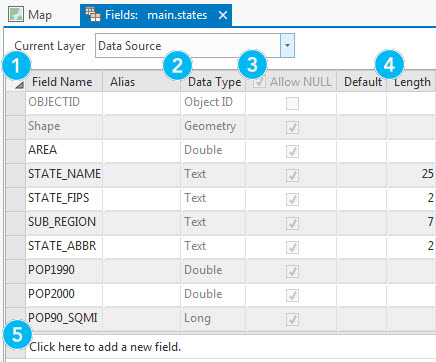You can connect to an SQLite database or GeoPackage file in ArcGIS Pro to create maps and perform spatial analysis on your data. SQLite databases and OGC GeoPackage files support a single-user connection. Both use a simple data model and are contained in one file, which can be advantageous for the exchange of data between software packages. For example, SQLite databases can be useful on mobile devices with limited connectivity to exchange data with a server when connectivity is reestablished. For more information about SQLite databases, visit the SQLite website.
You can store spatial information in an SQLite database using the Esri ST_Geometry spatial data type, SpatiaLite, or use the OGC GeoPackage spatial storage format. OGC GeoPackage files are interoperable across many environments and are useful on mobile devices. See the section below about creating a GeoPackage that conforms to the OGC specification.
Add an SQLite database or GeoPackage
You can access an SQLite database or GeoPackage file through a folder connection, or you can add the database or file to the project, similar to how you access a file geodatabase.
When you use a folder connection, you can see and work with all supported files stored in that folder. If you only want to see and work with the database or GeoPackage and not other items stored in the same folder, add the SQLite database or GeoPackage directly to the project.
To add an SQLite database or GeoPackage to a project, complete the following steps:
- Connect to a folder that contains the SQLite database or GeoPackage that you want to use.
- In the Catalog pane, browse to the folder to which you connected in the previous step.
- Right-click the SQLite database or GeoPackage, and click Add to Project
 .
. The SQLite database or GeoPackage appears in the Catalog pane in the Databases category.
- Browse to the SQLite database or GeoPackage to start using its items.

Tip:
If you do not want to add the database or GeoPackage to the project, you can use the contents of the database directly from the folder connection.
Add data to the map
To add data from an SQLite database or GeoPackage to the map, use the Add Data button  on the ribbon as described in the steps below, or drag the feature class or table onto the map from the Catalog pane.
on the ribbon as described in the steps below, or drag the feature class or table onto the map from the Catalog pane.
- Click the
Add Data button
 on the Map tab on the ribbon.
on the Map tab on the ribbon. - Browse to the SQLite database or GeoPackage when the Add Data dialog box appears.
- Click the table or feature class that you want to add to the map.
- Click Select.
Tip:
Alternatively, if you already added the SQLite database or GeoPackage to the project, you can right-click the feature class or table and choose Add to Current Map to add the data to the current map or Add to New Map to add the data to a new map in the project.
Work with data in fields view
In the Catalog pane, you can use the fields view to do the following in a table or feature class in SQLite or a GeoPackage (the numbers in the list correspond to the numbers in the image below):
- View field names.
- View field data types.
- Determine whether a field allows null values.
- View text field lengths.
- Add fields.
Tip:
Do not use field names that contain spaces or nonalphanumeric characters. See Database and cloud data warehouse data in ArcGIS for information about field name length.

In the Contents pane, you can use the fields view to modify the following layer properties highlighted in the image below.

Caution:
To add a field to a table or feature class in an SQLite database or a GeoPackage, you must open the fields view from the Catalog pane.
Regardless of how you open the fields view, you cannot use it to delete or rename a field in a table or feature class in an SQLite database or a GeoPackage.
Instead, you can use the Alter field geoprocessing tool to rename a field, or the Delete field geoprocessing tool to delete a field in a table or feature class in an SQLite database or a GeoPackage.
Create an SQLite database or GeoPackage
To create an SQLite database or GeoPackage in ArcGIS Pro using the Create SQLite Database geoprocessing tool, complete the following steps:
- Click the Tools button
 on the Analysis tab to open the Geoprocessing pane.
on the Analysis tab to open the Geoprocessing pane. - In the search box, type Create SQLite Database.
- Open the Create SQLite Database tool, fill in the parameters, and run the tool.